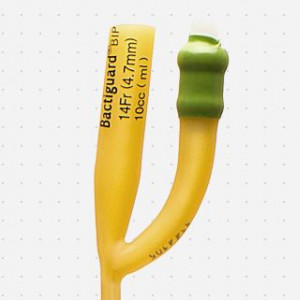| Bactiguard AB |

| Registration Date | 1 Jul 2018 |
| Revision Date | 1 Jul 2018 |
| Share |
Medicine Medical Supplies
Cathetergold-palladium-silver
Au-Pd-Ag Ultra-thin FilmSAVES LIVES REDUCES URINARY TRACT INFECTIONS REDUCES USE OF ANTIBIOTICS REDUCES HEALTHCARE COSTS
The Bactiguard Infection Protection Foley Catheter (BIP Foley Catheter), is an indwelling urinary catheter with Bactiguard coating which is proven to significantly reduce bacteriuria, symptomatic urinary tract infections and the use of antibiotics. The Bactiguard Infection Protection (BIP) technology is based on the application of a very thin noble metal coating, consisting of gold, palladium and silver to medical devices. The coating is firmly bound to the surface of the device and reduces the adhesion and growth of microbes.
The catheter is used for drainage and irrigation of the bladder, or for the collection and measurement of patient urine. It can be used trough urethra or suprapubically for up to 90 days and is available both in latex and silicone with Bactiguard coating. On top of the Bactiguard coating, the Foley catheters also have a hydrophilic coating, to reduce friction between the catheter surface and urethra when inserting the catheter aimed at increased patient comfort.
Catheter associated urinary tract infections (CAUTI) account for a large proportion of healthcare associated infections (HAI)1. These infections can result in serious complications such as urosepsis, which lead to patient suffering as well as increased mortality and healthcare costs2. In addition, many of these infections are treated with antibiotics, which increases the risk of emergence and spread of multi-resistant microbes. The risk of CAUTI increases with the number of days of catheterization and if the patients´s immune system is weak. Groups at risk include for example the critically ill and patients with urological malignancies and neurological diseases.
Bactiguard coated products have been used in a large number of clinical studies and evaluations (1986–2015) involving over 100,000 patients. In peer-reviewed studies looking specifically at the incidence of symptomatic CAUTIs in patients with >2 days of catheterization (in line with current standards), the weighted average reduction of infection was 35%.3,4,5,6,7. In certain studies a much larger reduction, of up to 70%, was observed5.
The Bactiguard solution is unique, tissue friendly and safe for patient use. As opposed to coating technologies which depend on the release of substances, which kill bacteria, e.g. large amounts of silver ions, chlorhexidine or antibiotics, the Bactiguard coating is neither toxic nor pharmacologic8. After 90 days in urine 99% of the coating is still bound to the surface of the BIP Foley Catheter, meaning there is only a minimal release9. To date, more than 150 million Bactiguard coated urinary catheters have been sold for patient use, with no reported adverse events related to the coating.
BIP Foley Catheter has been shown to reduce CAUTI in a cost effective way. Several health economic evaluations have been conducted in Europe and USA10,11,12,13. In one of these, a large, prospective, randomized study of almost 28 000 patients, Bactiguard coated catheters were shown to offer significant annual cost savings when considering the excess cost of CAUTI10. In another 2-year prospective surveillance study of 10 patient care units, the introduction of a Bactiguard coated urinary catheter was associated with a significant decline in CAUTI and led to reduced costs11. The costs savings were present in a wide variety of reimbursement systems10,11,12,13. BIP Foley Catheters are associated with lower length of hospital stay costs, treatment costs and improved patient quality of life12.